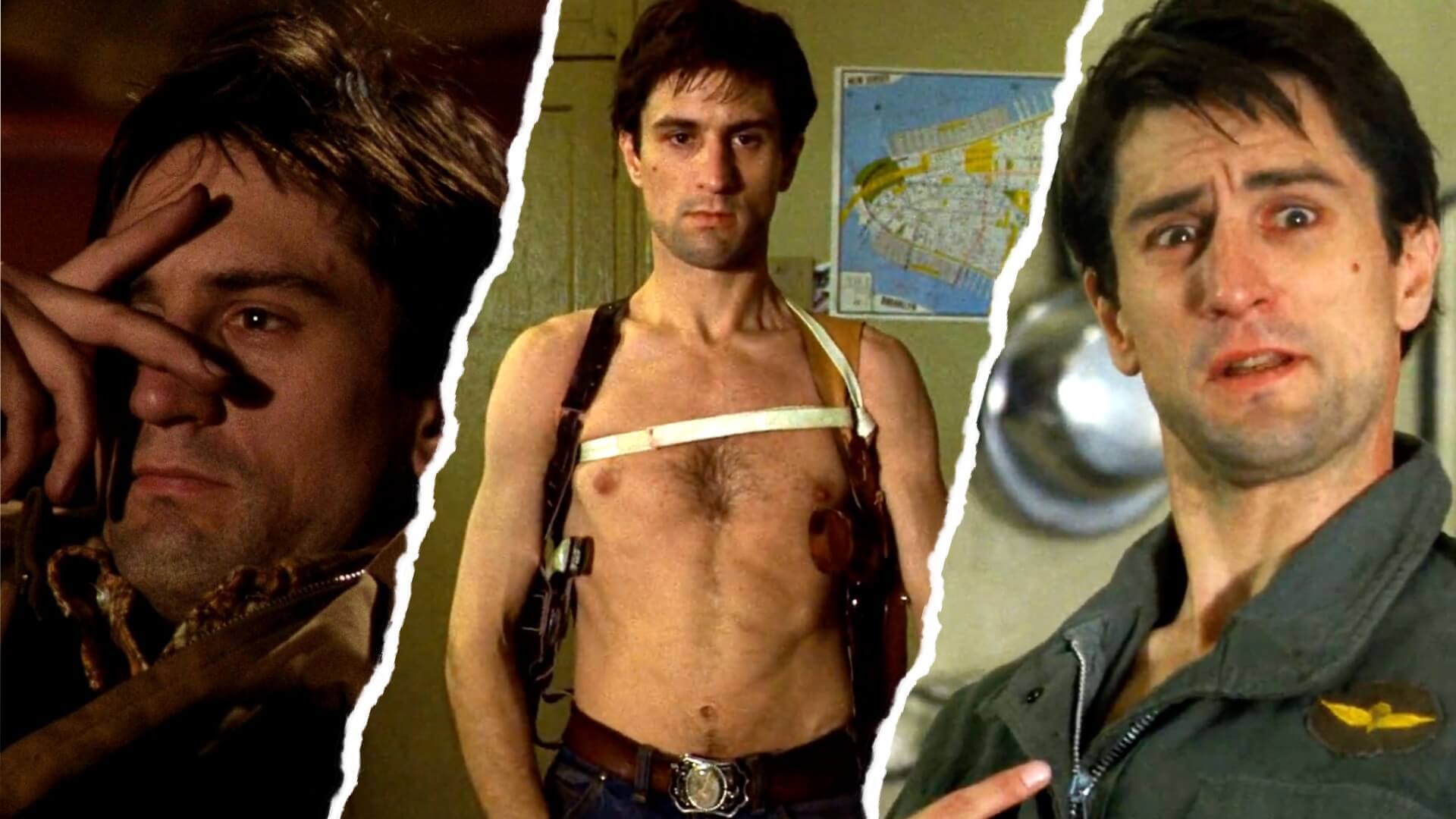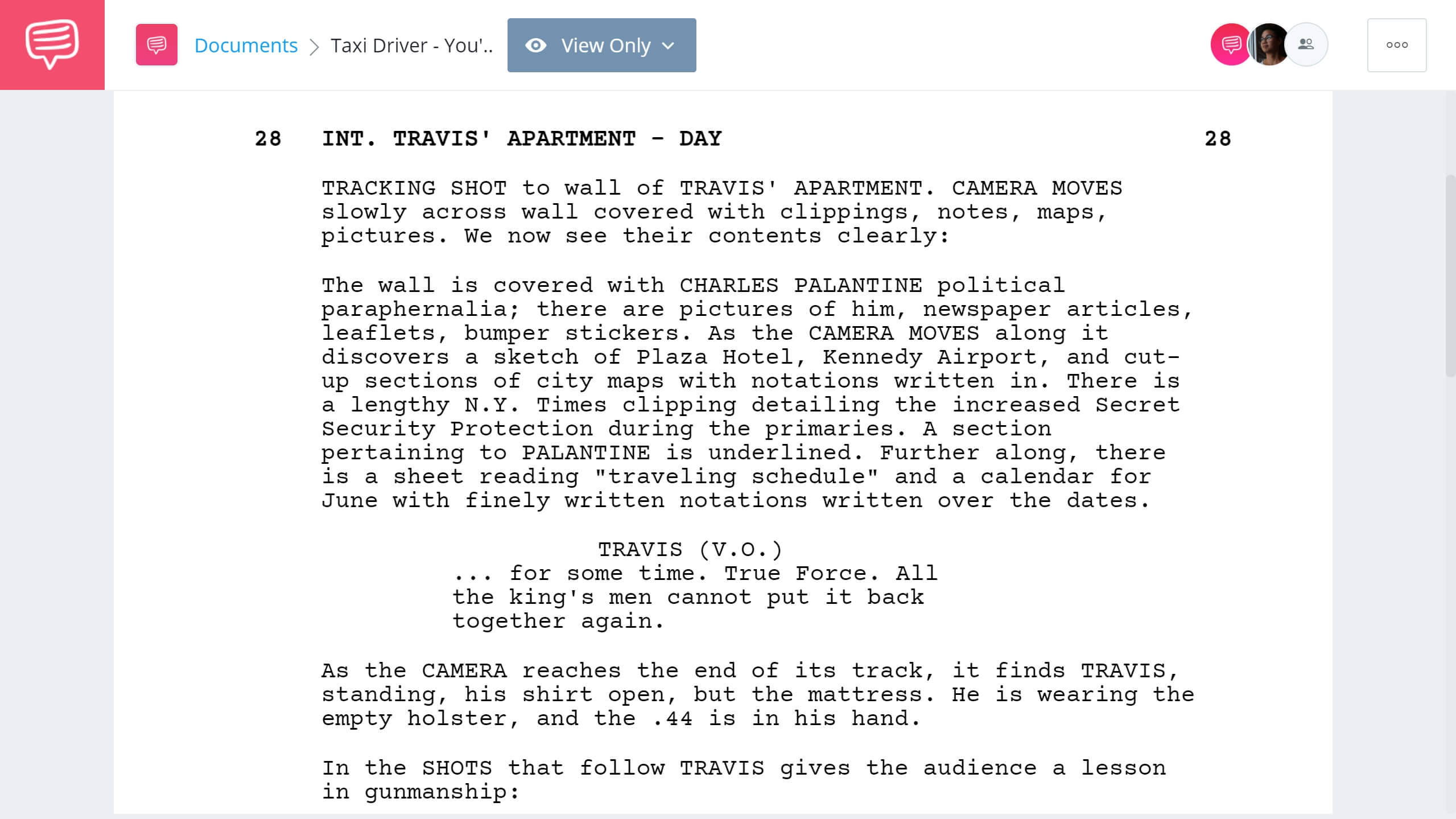Martin Scorsese is widely considered one of the finest filmmakers of his or any generation. Of his long list of masterpieces, his enduring classic Taxi Driver remains one of the most beloved. One scene in particular has permeated the zeitgeist in a way few scenes manage to do: the iconic and oft-quoted “You talking to me?” scene. Watch our Taxi Driver analysis, where we took aim at the directorial decisions that led to the scene becoming so iconic. And in this post, we’ll be digging into the details of how the “You talking to me” scene was made from the perspective of the three most important voices in the matter: writer Paul Schrader, Martin Scorsese, and Robert De Niro. To get started, check out our video essay exploring the iconic Taxi Driver monologue.
Taxi Driver you talking to me
Inside Paul Schrader’s script
Screenwriter Paul Schrader and director Martin Scorsese make for a cinematic dream team and have collaborated on a number of films. To see where Taxi Driver lands amongst the rest of Scorsese’s filmography, check out our ranking of every Martin Scorsese film.
Beginning with a script from Paul Schrader is a fantastic jumping-off point. For example, you will notice that there are integral elements in the finished film that were not present in the screenplay, including the iconic "You talking to me?" monologue.
Therefore, we brought the original Taxi Driver script into StudioBinder's screenwriting software so you could see how it was written compared to the finished scene.
You Talking to Me quote • Read the iconic Taxi Driver scene
Next, let’s hear from the writer himself as he discusses the origins of Taxi Driver. And, be sure to take a look at our guide to screenwriting vocabulary if you come across any unfamiliar writing terms.
The origins of Taxi Driver explained by Paul Schrader
Schrader set the tone of the story of the world it inhabits. He created the character of Travis Bickle as a form of self-therapy to help him out of a dark period in his life. Though he may not have scripted out the “You talkin’ to me?” monologue, it is safe to say that this monologue never would have come into existence without his original screenplay as a springboard.
As a result, Schrader created a framework that was conducive to the type of experimentation and improvisation that Scorsese excels at. Next, in our Taxi Driver analysis, we’ll examine what Martin Scorsese's directing style brings to the table.
Taxi Driver analysis
Martin Scorsese’s direction
As an avid cinephile, Scorsese is influenced by many cinematic works. He, of course, pulls inspiration from American films but he also draws influence from many foreign-language films as well. Therefore, this conflux of inspirations lends itself to Scorsese's style consisting of remarkably clear vision. Also, it allows an openness to experiment and explore both character and theme.
Here's Scorsese in his own words on the tragedy of Travis Bickle.
You talkin to me? • Taxi Driver explained by Martin Scorsese
Consequently, his flexible directorial spirit is what leads to some of the defining moments of Scorsese’s filmography, including the iconic "You talking to me" scene. Throughout the film, Scorsese switches between two distinct points of view: subjective (when we occupy Travis' headspace) and objective (when we observe his behavior as others do).
Perhaps the most interesting part of this scene is how we switch between an objective perspective of Travis Bickle to a more subjective glimpse inside his mind. For example, in the first half, Scorsese makes us objective observers as if we are in the room. He does this with a static camera, long takes, and diegetic audio that captures the ambient noise of the neighbors and the street outside.
Following that, in the second half of the scene, we lose that diegetic audio and replace it with voiceover narration and Bernard Herrmann’s dark and moody score. Also, the camera remains static but the editing kicks in to bend and twist reality — dissolving in between shots instead of cutting and a “double-edit” that replays the same moment twice.
Here's the scene broken down shot-by-shot using StudioBinder's storyboard creator. You can that the shift in perspective happens between Shot 6 & 7. Click the image link to explore and download the complete storyboard of the scene.
Within the confines of Travis Bickle’s messy, sweaty apartment, Scorsese and De Niro spent a great deal of time playing around with ideas that supported the themes of the film without being constrained by the screenplay. Hear more quotes and insights into Scorsese’s directorial techniques in the Taxi Driver commentary below.
Full-length commentary • Taxi Driver explained by Scorsese and Schrader
During the filming of the "You talking to me" scene, Scorsese was crouched below the camera lens, helping De Niro through his improvised monologue. Of course, improvisation is not carried out by the director alone. Which brings us to the star of the show.
The Taxi Driver monologue
Robert De Niro’s performance
The type of dramatic improvisation that leads to a moment like Travis Bickle’s mirror monologue is a collaborative effort between a director and their star. As a largely improvised scene, Scorsese trusted De Niro's instincts to embody Travis Bickle. And to let spontaneity become a part of the creative process.
This passion for improv and character exploration was something De Niro introduced to his co-star, Jodie Foster. You can learn how to develop stronger characters with our free worksheet.
Robert De Niro coached Jodie Foster through Taxi Driver scenes
The diner scene between Travis and Iris was one scene that was rehearsed extensively with an emphasis on improvisation and character exploration. Both with and without Scorsese’s involvement. De Niro would meet with 12-year-old Jodie Foster and encourage her to take her character beyond the page to really get to the core of who "Iris" was.
Taxi Driver scene • You talking to me?
This same sense of exploration is what led to the brilliance of the mirror monologue; a natural extension and deepening of the character as written on the page. The direct inspiration for the "You talking to me" scene itself came from a number of wildly diverse sources.
These included a mantra used by De Niro’s former acting teacher, Stella Adler. A question Bruce Springsteen posed to the audience at a concert. And a scene from Reflections in a Golden Eye where Marlon Brando spoke to himself in a mirror all contributed to the inception of the iconic Taxi Driver monologue.
This scene inspired the Taxi Driver mirror scene
This conflux of influences illustrates how the inspiration for great scenes can be found just about anywhere. If you want to jumpstart your own inspiration, you can look through our free creative writing prompts.
UP NEXT
The Irishman Scene Breakdown
If you are a fan of Martin Scorsese and enjoyed our breakdown of Taxi Driver’s most iconic scene, then you might be interested in our breakdown of a scene from Scorsese and De Niro’s most recent collaboration, The Irishman. How does Martin Scorsese open up an epic? Find out, up next.
Up Next: Irishman Breakdown →
Share your vision with elegant shot lists and storyboards.
Create robust and customizable shot lists. Upload images to make storyboards and slideshows.


